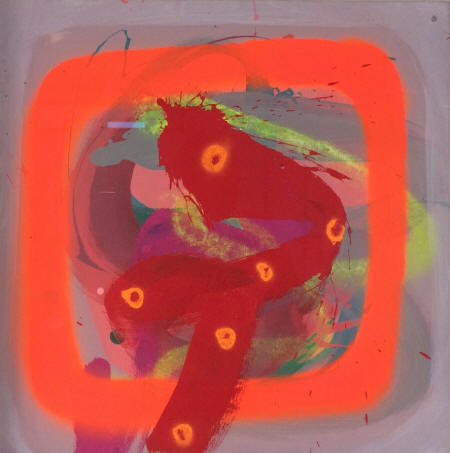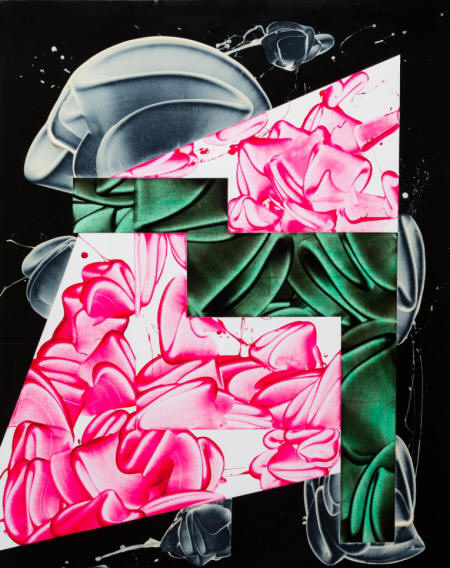|
|
| home | exhibitions | interviews | features | profiles | webprojects | archive |
|
Concrete Abstraction A response to the exhibition 'After Illusion' by Prof. John Baldacchino. 11/4/17.
Here we are engaged with six artists whom we must consider as fellow combatants in the struggle to take abstraction from the simple encounter by which one begins to compare art with representation, to the concreteness of painting as abstraction in se. Abstraction is no illusion. If it were to give a sense of illusion, itís because abstract art is ó i.e. it has being as such; which means that in itself, art is immanently a concrete abstraction. The painterís struggle is confronted by what the painter is, as that human being who in being other than paint, canvas, or board, becomes the concrete being of what is demanded by his or her decision to engage with abstraction. As one insists on the rigorous How? of painting, and how it immanently holds its essence by dint of its concrete existence, one also becomes intransigent with the Why? which is demanded by the object that is artís event as a concrete intention. This means that the painter risks and seeks mistakes because he or she is the one who understands the centrality of artís paradox as that object which refuses to be an object of others. Concrete abstraction means that there are neither objects nor subjects; which is where the making of an abstract work of art is identified with its own being. Artís being is coextensive with itself. It is the same as the one universe beyond which monists like Spinoza and Marx expect to find nothing.
In playing a role in this universe, where ground and horizon are the same thing, and where we inhabit the narrative of art as inseparable from what the art is (in this case a painting), I then want the work of art to take me where I canít go when I am speaking, or even engaging with images. I want art to help me inhabit the impossible space that we know cannot exist except in that which art in its investment does not monetize as a price but as a value that is unique in all senses possible. Here one finds artís investment in its own monistic universe; in its capacity to concretise its own abstraction through those abstract forms by which painting, in its plastic materiality, brings to us an event of form. This form may well be a Platonic abstraction qua idea. But in being thus, it becomes an object of what it subjectively invests in the world that we construct by dint of our existence. Just being there as artists, we are an affirmation of this possible concrete abstraction that stays put and never transcends, except to project in constant repetition, itself onto itself. One must always speak of the technical rigour that makes painting unique amongst all artistic manifestations. In being partisan for the painterly, one regards him or herself as one of those conservative purists who, unlike the conservative and the purist, insists on the art formís autonomy from any judgement which has been customarily given by the academy or by those who seem to think that artís speciality elevates it from the rest.
A painting (noun) must be seen for what it is: a result of painting (verb). Painting is an act of layering. It is a repetitive act of glazing that finds itself under itself; a process by which the notion of a method is thrown outside the confines of what is often described by moralists and social scientists as artís necessary act of goodness.
There is nothing good or evil about art, in that art has nothing to
moralize about except that which is artís moral ó an autonomy which in
its heteronomous being, allows us to know the world in infinite ways. As
this remarkable body of work confirms, painting represents the stretch
on which we go on to undefine colour, to never redefine it again except
in indirect ways where the viewer has to simply touch with her eyes what
is never touched by the hand ó as that handís touch is reserved for
those who have dared to make art and present it to If this short essay makes only poetic sense, then one could say that its success lies in its attempt to stay away from describing art works or celebrate their artists. For that, he or she needs to find another means, by which a description comes to the aide of those who misunderstand abstraction as that which moves away from the concreteness of being. And here, concreteness is not the idea of the concept, but the paint, board and material on which these artists chose to concretise abstraction. As the artistsí claim is to come ďafterĒ the Illusion, I would suggest that the audience keeps waiting for when the illusion returns ó though I suspect that in a monist universe there is no return because nothing tends to depart.
|
|
|


